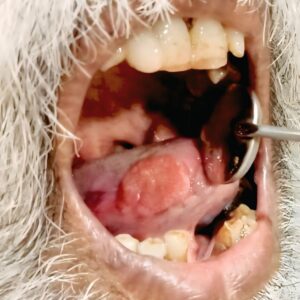
Expose the Hidden Danger: Mouth Signs Emerge 1-2 Days Before Measles Symptoms
Introduction
Measles, a highly infectious viral illness caused by the measles virus (Paramyxoviridae family member), remains a public health problem in the face of effective vaccines. Although measles is classically described by its systemic nature, fever, rash, and respiratory illness, its oral form is noteworthy for its early diagnosis and management. The oral cavity is generally an indication of overall health, and in the case of measles, some oral findings are noteworthy signs for clinicians

Table of Contents
Understanding Measles and Its Systemic Manifestations
Measles is caused by direct contact and droplet infection and is therefore one of the most infectious of all diseases. The infection is mostly prevalent in children but can occur in unvaccinated adults or in immunosuppressed individuals too. The typical incubation period ranges from 7 to 14 days. The virus replicates in the respiratory tract and lymphoid tissues for this period and then spreads to the rest of the body.
Common measles symptoms are:
1. Flu:
Typically, the first sign, fever can rise up to 40°C or more, marking the onset of the prodromal stage.
2. Inflammatory symptoms:
This includes a cough, a runny nose, and conjunctivitis, which affects both the respiratory and eye systems.
3. Rash:
A maculopapular rash occurs three to five days from the onset of the first measles symptoms, starting on the face and extending to the trunk and limbs.
4. Malaise and Fatigue:
Malaise and general weakness follow the infection and are a result of the body’s immune response.
5. Lymphadenopathy:
Lymph nodes may become swollen as lymph tissue is infected by the virus.
These systemic manifestations of measles are important to diagnose, but the oral cavity will often show the first and most typical measles symptoms, and is therefore of prime importance to the clinician.
Oral Manifestations of Measles: The Most Important Diagnostic Clue
The oral cavity is among the first sites of the presence of measles, often preceding the typical rash. Oral findings are not only diagnostic criteria but also demonstrate the systemic nature of the condition. We provide the summary of the most significant oral manifestations of measles symptoms and clinical significance below.
1. Koplik's spots: The pathognomonic sign
Koplik’s spots are also considered to be a pathognomonic oral presentation of measles and are most frequently called pathognomonic, i.e., h. They are extremely specific for the illness. They are small white or bluish-whitish oral mucosal lesions (in the cheeks) and sometimes on the soft palate or gums. They are typically 1 to 3 mm in size with an erythematous (red) halo and appear as grains of salt on a red background.
- Time: Koplik spots will generally occur 1 or 2 days prior to the rash in the prodromal phase and are therefore an useful aid to early diagnosis.
- Pathological Physiology: Spots develop as a consequence of viral replication within the usual mucosal epithelium and lead to local inflammation and epithelial necrosis.
- Clinical Significance: Their presence is an indicator of measles and allows physicians to differentiate it from other viral exanthems such as rubella or roseola. Koplik’s spots are transient and can clear as early as 48 hours following the onset of the rash, and thus an early oral examination is crucial.
2. Inflammation and Erythema of Oral Mucosa
In addition to Koplik spots, oral mucosa may also present diffuse erythema, particularly of the oral mucosa, palate, and pharynx. The erythema is a consequence of the measles virus tropism for mucosal tissues and leads to vasodilation and inflammation.
- Appearance: The mucosa may be bright red or mottled in certain cases.
- Associated measles symptoms: The patient may complain of pain or discomfort in the mouth due to mucosal irritation, particularly on ingestion and drinking.
- Diagnostic value: Although mucosal erythema is less specific than Koplik spots, used in combination with other systemic presentations of measles such as fever and cough, it is useful in the diagnosis of measles.
3. Gingival Involvement
Gums may also be affected by measles, with redness, swelling, or bleeding. Gingival involvement is less common but happens in very severe instances or with secondary bacterial infections complicated in the illness.
- Mechanism: Systemic impact of the virus inhibits the immune system, making the gums susceptible to inflammation or opportunistic infection.
- Clinical Consideration: The gingival changes may be mistaken for periodontal disease or other viral infections, and therefore clinical practitioners must relate these findings to systemic symptoms of measles.
4. Pharyngeal and Tonsillar Involvement
The tonsils and pharynx are typically involved in measles with signs of inflammation. The patient may have a sore throat, dysphagia, or hoarseness of voice, which are typically presenting measles symptoms.
- Appearance: The pharynx may be inflamed and reddened with hypertrophic tonsils and may have white spots or exudate, which mimics bacterial tonsillitis.
- Differential Diagnosis: Clinicians need to distinguish measles-related pharyngitis from streptococcal pharyngitis or mononucleosis, usually on the basis of Koplik’s spots or subsequent rash.
5. Oral Ulcerations
Small erosions or ulcers on the oral mucosa in some individuals, especially those with severe or long-term infections, can occur. These ulcers are shallow and painful and are due to necrosis of the epithelium by viral replication or immune damage.
- Significance: Although less frequent than Koplik’s spots, ulcers in the mouth are of lesser consequence but can be painful and will, in the event of poor oral hygiene, lead to secondary infection.
The Oral Manifestations in Diagnosis Role
The oral findings of measles are worth their weight in gold for early detection, particularly during the prodrome when systemic symptoms of measles such as fever and cough are nonspecific. Koplik’s spots are considered a key diagnostic indicator for measles, as they appear prior to the development of the rash and are particularly distinctive for this disease. Dentists, primary care providers, and pediatricians need to inspect the oral cavity in patients who come in with fever and respiratory complaints routinely, particularly in regions of low vaccination coverage or during measles outbreaks.
Early identification of these oral signs can:
1. Facilitate Early Diagnosis:
Early diagnosis of mucosal alterations or Koplik’s spots facilitates early confirmation of measles, allowing early isolation to prevent spread.
2. Guide Treatment:
There is no antiviral treatment for measles and thus early initiation of supportive treatment (e.g., fluid and fever management) can be initiated to avoid complications.
3. Avoid Complications:
Oral findings can predict the disease severity, and more follow-up is indicated for complications such as pneumonia or encephalitis.
Systemic Measles Signs and Oral Relationship
The oral findings of measles resemble the systemic evolution of the illness. Viral growth in mucosal and lymphoid tissues during the prodrome produces mouth and systemic findings. For example:
- Koplik’s Spots and Fever: Highest fever is experienced when Koplik’s spots appear, because the virus replicates to the highest degree in mucosal tissues.
- Rash and Oral Changes: Maculopapular rash occurs following the resolution of Koplik’s spots, indicating the spread of the virus to the skin.
- Immune Suppression: Measles causes temporary immunosuppression, which may exacerbate oral inflammation or further increase susceptibility to subsequent oral infection.
Identification of this interaction between oral and systemic manifestations of measles is important for the clinicians to well understand the disease and administer proper care.
Management of Oral Manifestations
Although measles is managed with symptomatic treatment only, oral treatment can reduce patient discomfort and prevent complications. Some of the main procedures are:
- Oral Hygiene: Encourage gentle brushing and rinsing using a mild antiseptic mouthwash to reduce the risk of secondary infection of ulcerated or inflamed mucosa.
- Pain Relief: Topical analgesics (e.g., lidocaine gel) or over-the-counter analgesics to ease pain due to oral ulcers or sore throat.
- Nutrition and Hydration: Oral sore patients will usually refuse fluids and food, so it is vital that soft, non-irritating foods and adequate fluids are offered.
- Monitoring for Complications: Severe inflammation of the gingiva or chronic ulcers should be investigated further to rule out bacterial superinfections.
- Symptomatic Treatment: There is no specific drug that has been proven to be promising in treating measles. The patients are given drugs depending on symptoms like pain and fever.
Public Health Implications and Prevention
The oral presentations of measles emphasize the importance of immunization because measles-mumps-rubella (MMR) vaccine is highly effective in preventing measles. Outbreaks will happen in unimmunized populations, and early detection of oral findings like Koplik’s spots will avoid transmission by isolating the patient early and tracing contacts.
Public health interventions must be directed towards:
- Immunization Campaigns: Sustaining high levels of MMR vaccination, particularly among children, to reach herd immunity.
- Training: Health workers training in the identification of measles oral signs to allow for early diagnosis.
- Awareness: Informing communities regarding symptoms of measles, including oral symptoms, for early medical consultation.
Conclusion
Oral presentations of systemic manifestations of measles are a significant part of the disease, offering an early clue to the diagnosis and evidence of its systemic nature. Koplik’s spots, mucosal erythema, gingivitis, and pharyngitis are significant signs that need to be recognized by clinicians in order to diagnose measles and offer appropriate care. Identification of these oral manifestations can enable healthcare professionals to increase diagnostic yields, improve patient outcomes, and enable public health interventions to control this vaccine-preventable disease. Vaccination remains the pillar of measles prevention, and enhanced awareness of oral as well as systemic manifestations of measles can enable communities to respond early in the event of an outbreak.







